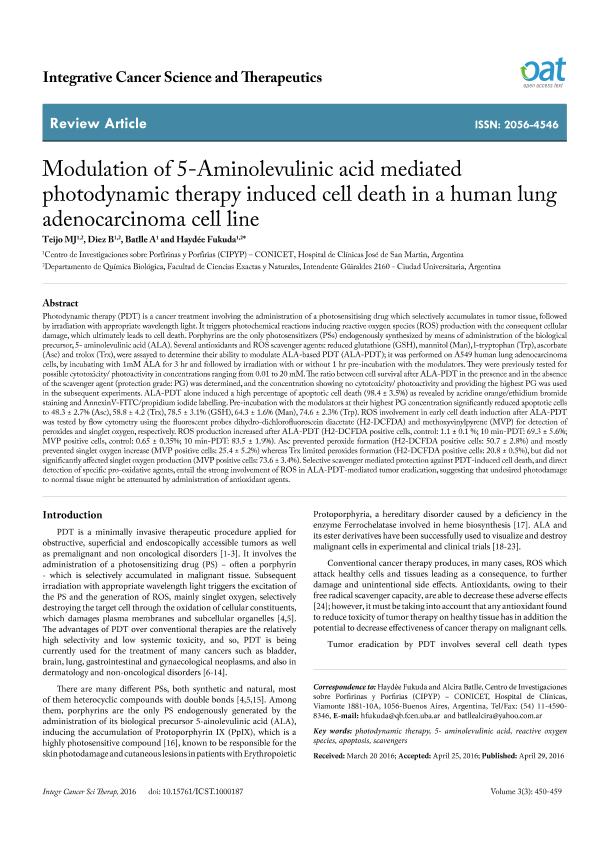Artículo
Modulation of 5-Aminolevulinic acid mediated photodynamic therapy induced cell death in a human lung adenocarcinoma cell line
Fecha de publicación:
05/2016
Editorial:
Open Access Text
Revista:
Integrative Cancer Science and Therapeutics
ISSN:
2056-4546
Idioma:
Inglés
Tipo de recurso:
Artículo publicado
Clasificación temática:
Resumen
Photodynamic therapy (PDT) is a cancer treatment involving the administration of a photosensitising drug which selectively accumulates in tumor tissue, followed by irradiation with appropriate wavelength light. It triggers photochemical reactions inducing reactive oxygen species (ROS) production with the consequent cellular damage, which ultimately leads to cell death. Porphyrins are the only photosensitizers (PSs) endogenously synthesized by means of administration of the biological precursor, 5- aminolevulinic acid (ALA). Several antioxidants and ROS scavenger agents: reduced glutathione (GSH), mannitol (Man), l-tryptophan (Trp), ascorbate (Asc) and trolox (Trx), were assayed to determine their ability to modulate ALA-based PDT (ALA-PDT); it was performed on A549 human lung adenocarcinoma cells, by incubating with 1mM ALA for 3 hr and followed by irradiation with or without 1 hr pre-incubation with the modulators. They were previously tested for possible cytotoxicity/ photoactivity in concentrations ranging from 0.01 to 20 mM. The ratio between cell survival after ALA-PDT in the presence and in the absence of the scavenger agent (protection grade: PG) was determined, and the concentration showing no cytotoxicity/ photoactivity and providing the highest PG was used in the subsequent experiments. ALA-PDT alone induced a high percentage of apoptotic cell death (98.4 ± 3.5%) as revealed by acridine orange/ethidium bromide staining and AnnexinV-FITC/propidium iodide labelling. Pre-incubation with the modulators at their highest PG concentration significantly reduced apoptotic cells to 48.3 ± 2.7% (Asc), 58.8 ± 4.2 (Trx), 78.5 ± 3.1% (GSH), 64.3 ± 1.6% (Man), 74.6 ± 2.3% (Trp). ROS involvement in early cell death induction after ALA-PDT was tested by flow cytometry using the fluorescent probes dihydro-dichlorofluorescein diacetate (H2-DCFDA) and methoxyvinylpyrene (MVP) for detection of peroxides and singlet oxygen, respectively. ROS production increased after ALA-PDT (H2-DCFDA positive cells, control: 1.1 ± 0.1 %; 10 min-PDT: 69.3 ± 5.6%; MVP positive cells, control: 0.65 ± 0.35%; 10 min-PDT: 83.5 ± 1.9%). Asc prevented peroxide formation (H2-DCFDA positive cells: 50.7 ± 2.8%) and mostly prevented singlet oxygen increase (MVP positive cells: 25.4 ± 5.2%) whereas Trx limited peroxides formation (H2-DCFDA positive cells: 20.8 ± 0.5%), but did not significantly affected singlet oxygen production (MVP positive cells: 73.6 ± 3.4%). Selective scavenger mediated protection against PDT-induced cell death, and direct detection of specific pro-oxidative agents, entail the strong involvement of ROS in ALA-PDT-mediated tumor eradication, suggesting that undesired photodamage to normal tissue might be attenuated by administration of antioxidant agents.
Archivos asociados
Licencia
Identificadores
Colecciones
Articulos(CIPYP)
Articulos de CENTRO DE INVEST. SOBRE PORFIRINAS Y PORFIRIAS
Articulos de CENTRO DE INVEST. SOBRE PORFIRINAS Y PORFIRIAS
Citación
Teijo, Maria Julieta; Diez, Berenice Andrea; Battle, A.; Fukuda, Haydee; Modulation of 5-Aminolevulinic acid mediated photodynamic therapy induced cell death in a human lung adenocarcinoma cell line; Open Access Text; Integrative Cancer Science and Therapeutics; 3; 3; 5-2016; 450-459
Compartir
Altmétricas




